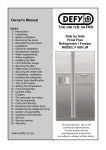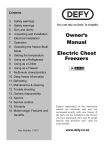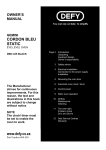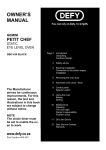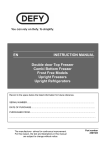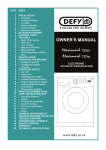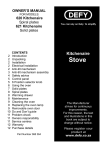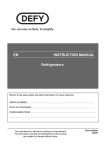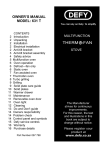Download Defy C375 Owner`s manual
Transcript
NO FROST COMBI Owner’s Manual REFRIGERATOR Manufacturer Model C375 More efficient A A B C D E F G G Less efficient 366 Energy consumption kWh/year (based on standard test results for 24 h) Actual energy consumption will depend on how the appliance is used and where it is located 244 68 Net volume of Fresh food compartment. (l) Net volume of Freezer compartment. (l) 41 AF RIC A VE TI G Y A Norm EN 153 May 1990 Refrigerator Label Directive 94/12/CE L AND EN ERG ER A IN Y M H UT Further information is contained in the product brochure F NT O Noise (dB ( A ) re 1 pW ) SO www.defy.co.za Energy ER PAGE 1 OF 15 energy efficient EN Contents 2 Know your refrigerator 3 Reference pictures 4 Safety notes 5 Introduction 5 Unpacking 5 Installation 5 Electrical installation 6 Operation 6 Setting the operating temp. 6 Control panel functions 6 Focus Cool 6 Freezer Set 6 Eco Fuzzy 7 Quick Freeze 7 Actual refrigerator temp. 7 Actual freezer temp. 7 Freezer graphs 7 Function icons 7 Alarm icon 8 The fridge compartment 8 Odour filter 8 Normal operating noise 9 The freezer compartment 9 Making ice cubes 9 If there is a power failure 10 Defrosting 10 Replacing a faulty light bulb 10 Cleaning 10 Moisture formation 11 What if… 12 Technical specifications 12 Owners responsibility 12 Problem check 13 Trouble shooting 14 Service Centres 15 Warranty You can rely on defy. To simplify D EP ART ME Model C375 M (DFC386) EF F IC IE N C Y IN Issue 1 IT I Know your refrigerator A) Refrigerator B) Freezer 2A 1. Control panel (on front of door) 2. Interior light 2A. Wire bottle rack 3. Movable shelves 4. Thermostat knob 5. Crisper cover 6. Salad crisper 7. Ice tray 8. Freezer compartment 9. Adjustable front feet 10. Adjustable door balconies 11. Egg tray 12. Large door balcony for bottles Control panel (on front of door) a) b) c) d) e) f) g) PAGE 2 OF 15 Focus Cool button Freezer Set button Eco-Fuzzy button Quick Freeze button Actual Fridge temperature Actual freezer temperature Freezer Bar Graphs Reference pictures Instructions throughout this manual refer to the pictures and numbers depicted below. 3 4 5 6 7 8 9 10 11 12 13 PAGE 3 OF 15 up down Safety Notes This appliance is not intended for use by persons with reduced physical, sensory or mental capabilities or lack of experience and knowledge unless they have been given supervision or instruction concerning the use of the appliance by a person responsible for their safety. Children should be supervised to ensure that they do not play with the appliance. WARNING: Keep ventilation openings, in the appliance or in the built-in structure, clear of obstructions. Do not use mechanical devices or other means to accelerate the defrosting process, other than those recommended by the manufacturer. Do not damage the refrigerant circuit. Do not use electrical appliances inside the food storage compartments of the appliance. This appliance must only be used for its intended purpose, i.e. the storing of edible foodstuff. Avoid touching the metal condenser at the rear of the refrigerator as wires and sharp edges could cause an injury. Never pour or spray water into the appliance and do not store liquids, pot plants or open containers on top of the appliance as these might spill causing electrical shorting. Do not allow children to hang on the appliance door as the appliance could topple forward risking personal injury. Do not store medicine or academic research samples which require strict temperature control in the appliance Do not store or use flammable gas, benzene, petrol or volatile substances in or near the appliance. Unplug the appliance when cleaning, during routine maintenance or if it will not be used for an extended period. In the event of a malfunction, disconnect the appliance from the power supply. Repairs should only be made by a qualified technician. If the connection cable is damaged, a qualified technician must replace it. When discarding an old appliance please render the doors inoperative as children ,while playing, might get trapped inside and suffocate. Do not dispose of this appliance in a fire as it contains non CFC substances in the insulation which are flammable. Please contact the local authority for information on disposal methods and available facilities. NOTE: The appliance contains no fluoridated coolants but contains Isobutene (R 600 a), a natural gas which is highly compatible with the environment. Under certain conditions however it is flammable and simple preventative precautions should be observed. Ensure that the cooling circuit is not damaged either during transport or during operation. In the event of damage; Immediately air the room in which the appliance is located and do not expose the appliance to an open flame, sparks or flammable substances. Exposure to the coolant could cause eye injuries See a doctor immediately. PAGE 4 OF 15 Introduction. Congratulations on the purchase of this quality refrigerator. We trust that you will enjoy many years of trouble free use. Please read these instructions carefully as they will provide you with information on how to operate and care for your refrigerator in order that you gain the maximum benefit from it. Unpacking. Do not connect the refrigerator to the power supply until all packing and transit protectors have been removed. Please memorise the position of accessories so that after unpacking and cleaning, they may be repositioned correctly. Please ensure that packaging material is disposed of in a responsible manner. Plastic bags should be cut up to prevent children playing with them and accidentally suffocating. If the refrigerator is damaged in any way, do not use it. Report the damage to your dealer, who will take the necessary corrective action. Allow the refrigerator to stand upright for at least 1/2 an hour before switching on the power. This will allow fluids in the system to settle. Installation. The appliance should be positioned in a dry, well aired place, and away from heat sources such as stoves, geysers and direct sunlight. We do not recommend locating the refrigerator in an outdoor environment. Allow an unobstructed air space at the sides and top of the refrigerator for ventilation purposes. (fig 3) Fit the two plastic wall spacers (supplied) to the condenser at the rear of the refrigerator by rotating them 1/4 turn. (fig 4) It is essential to level the unit by turning the two adjustable levelling feet at the front of the unit either in or out. (fig 5) It is advisable to adjust the cabinet so that it tilts slightly backwards. This will assist the door to close and help the magnetic gasket maintain a good seal. Electrical installation. This refrigerator must be earthed and the manufacturer and the seller do not accept responsibility for any damage due to incorrect electrical connection. The refrigerator must be connected to a 220-250V –50Hz electricity supply via a 15A3 pin plug and an earthed wall socket in a readily accessible position. If the mains power cord is damaged, it must be replaced by a qualified electrician. We do not recommend the use of adapter plugs or extension cords. PAGE 5 OF 15 Operation Switch on the power at the wall plug. The compressor will run. The interior light will switch on when the refrigerator door is opened. Setting the operating temperature The freezer compartment temperature can be set on the control panel. The temperature of the fridge compartment depends on the amount of air flowing from the freezer compartment. This air flow may be regulated by turning the knob on the rear wall of the refrigerator compartment. (fig 6) 1 being the warmest setting and 5 being the coldest. Control panel functions A) Focus cool Press the Focus Cool button (a) to activate fuzzy cooling of the refrigerator. The focus cool icon (h) will light up. Focus cool automatically reacts to rapid temperature changes in the refrigerator compartment such as when the door is opened or when a large amount of food has been placed in the refrigerator. Focus Cool aims to preserve and protect the stored food against these sudden temperature changes. Provided it has not been deactivated, Focus Cool will automatically resume after a power outage. This is particularly advantageous as power interruptions can be detrimental to cold storage. To deactivate the Focus Cool function, press the Focus Cool button (a) once more. b) Freezer set The freezer temperature may be adjusted by pressing the Freezer Set button. (b) The first time the button is pressed the current set temperature is shown on the display. Thereafter, each time the button is pressed a new freezer set temperature will be displayed in the following sequence: -18, -20, -22, -24, -18,… The Freezer Set temperature will blink in the display for 5 seconds only, thereafter the actual freezer temperature (f) will be shown. c) Eco Fuzzy Press the Eco Fuzzy button (c) to operate the refrigerator in the most economical mode using fuzzy algorithms. The Eco Fuzzy icon (j) will light up. Provided it has not been deactivated, Eco Fuzzy will automatically resume after a power outage. To deactivate the Eco Fuzzy function, press Eco Fuzzy button (c) once more. PAGE 6 OF 15 b) Quick Freeze Press the Quick Freeze button (d) to start the Quick Freeze function. The quick freeze icon (k) will light up and –27 will blink on the display for about 5 seconds. Thereafter the actual freezer (f) temperature will be displayed. The Quick Freeze function lasts for a maximum of 3 hours. Thereafter the Quick Freeze icon (k) will dim and the previous Freezer Set temperature will be recalled. To deactivate Quick Freeze function manually, press the Quick Freeze button (d) once more or press the Freeze Set button (b). The electronic control incorporates a safety protection system which will prevent the compressor from responding immediately should the quick freeze button be pressed more than once in a short period. e) Actual refrigerator temperature The Actual Fridge Temperature shows the average temperature of stored food in the refrigerator compartment. Accordingly this temperature is not sensitive to rapid temperature changes such as when the door is opened. f) Actual freezer temperature The Actual Freezer Temperature shows the average temperature of stored food in the freezer compartment. Accordingly this temperature is not sensitive to rapid temperature changes such as when the door is opened. g) Freezer bar graphs The number of bars displayed reflect the temperature selection. The more bars displayed, the colder the temperature. If –24 is selected, all the bars are illuminated If –18 is selected, 6 bars will be illuminated. h,i,j,k) Function Icons These indicate that the relevant function (Focus Cool – Economy - Eco Fuzzy - Quick Freeze) has been selected and is operational. l) Alarm Icon The Alarm icon indicates that there is something wrong with the refrigerator wiring or system. Please check the What If section. PAGE 7 OF 15 The refrigerator compartment The refrigerator compartment is intended for the short-term storage of fresh food and drinks. Never keep any dangerous or poisonous substances inside the refrigerator. Do not store explosive substances, volatile liquids, or containers with propellant gas (spray cans) in the refrigerator. Do not obstruct the air circulation inside the refrigerator by covering the shelves. Foods with strong aromas should be stored in sealed containers to prevent flavour transfer to other foods. Bottles are best stored upright in the door balcony. Store alcohol in tightly closed containers and only in an upright position Allow hot foods to cool to room temperature before storing them in the refrigerator. Clean fresh food and vegetables before storing them in the crisper. Do not place frozen foods over the crisper cover for thawing purposes (fig7). Other shelves may be used for this purpose. Always pack or wrap food, or put it in a suitable container, before storing it in the refrigerator. Wrap food which is not suitable for storage at cold temperatures in polyethylene bags (pineapple, melons, cucumbers, tomatoes etc.). Keep fresh food separate from cooked food, to avoid bacteria contamination. Never keep fresh meat in the fridge for more than 2 or 3 days. Remove any left-over canned food from the can and store it in a suitable container. Refer to the shelf life indicated on the food packaging. Always check that food , stored for long periods, is still fit for consumption. Close the door immediately after opening, to avoid unnecessary energy consumption. Odour filter. The odour filter located at the back wall of the refrigerator compartment prevents the formation of unpleasant odours in the refrigerator. To clean the filter, remove the plastic cover ( fig 13) Place the filter where it may br exposed to direct sunlight for a day. This cleans and rejuvenates the filter. Re-fit the filter after this time. Normal operating noise Hard surfaces such as ceramic floor tiles, wooden floors, walls and kitchen cabinets may amplify or deflect the operating sounds making them more noticeable . Typical noises associated with a modern refrigeration system are: A compressor hum, gas expansion and gurgling sounds. These sounds are normal and are usually an indication that the refrigerator is operating properly. PAGE 8 OF 15 The freezer compartment The freezer compartment has a 4 star rating ( highest available for domestic freezers). This means that not only is it suitable for the long term storage of frozen foods, it can also be used to freeze fresh food such as meat , fish , vegetables and fruit out of season. If you are loading bulk into the freezer, load one quarter at a time and allow to freeze before loading the next quarter. Divide food into reasonable portions according to your requirements. Allow hot food to cool before putting it in the freezer. Seal all foods or place in airtight containers to prevent dehydration. Remember, liquids can increase in volume when frozen. Do not store sealed bottles, jars or cans in the freezer as the contents will freeze, expand and rupture the container. Do not exceed the expiry date shown on food packs. Never re-freeze defrosted food; defrosted food must be consumed within 24 hours. Only food that has been cooked can be refrozen. Do not take out frozen food with wet hands. You could stick to the frozen food. Always use appropriate packaging material to avoid odour penetration or degradation of the food. Store commercially frozen food in accordance with the instructions given on the packs. Freeze cooked food in small quantities. This ensures rapid freezing and maintains the quality of the food. Transport pre-frozen food from the supermarket in foil lined cooler bags and transfer to the home freezer as soon as possible. Note It may be difficult to open the freezer door just after it has been closed. This is a normal phenomenon and is caused by the partial vacuum created by the pressure difference that exists between the inside and the outside the freezer. This will equalise after a few minutes allowing the door to once more be opened normally. Making ice cubes Fill the ice-cube tray 3/4 full with water and place it in the freezer. To facilitate the removal of the frozen cubes from the tray, allow them to thaw slightly or put the bottom of the tray in water for a short moment. Never use sharp objects such as knives or forks to remove the ice tray or cubes as these pose an injury risk and could also damage the freezer. What if there is a power failure Keep the doors of your freezer closed. Frozen food will not be affected if the power failure lasts less than a few hours. If the power failure lasts longer, it is best to first cook the defrosted food and then refreeze it. PAGE 9 OF 15 Defrosting The Appliance is Frost Free and will not require manual defrosting. Refrigerator defrost water will be channeled to an evaporation pan located above the compressor at the rear of the refrigerator. (fig 8) Ensure that the drain pan is firmly secured above the compressor. To replace a faulty light bulb proceed as follows: Switch of at the wall socket and remove the power plug from the socket. Unscrew and replace the faulty bulb with an E14 screw cap type 15 Watt bulb (fig 9 and 10). Cleaning Always disconnect the plug from the mains socket before cleaning any part of the refrigerator. Clean the inside of the appliance whenever necessary using a damp cloth and a solution of warm water and Bicarbonate of Soda ( 1 table spoon to every 2 litres of water ). Dry with a soft cloth. Do not use pot scourers or abrasive powders to clean the appliance. Spillages, especially citric and acidic juices, must be wiped up immediately as they could stain the product. Shelves, freezer baskets, crispers and door shelves may be removed for cleaning purposes.(fig11 and12) The back of the unit may be vacuumed or dusted using a soft bristle brush. A mild furniture polish may be used on the exterior cabinet to add lustre and protect against finger marks. If the refrigerator will not be used for an extended period, it is best to unplug at the wall socket and leave both doors slightly ajar. This will prevent unpleasant odours from forming. Inspect the door gaskets at regular intervals and clean with water only. Wipe dry. Moisture formation in the refrigerator compartment. If the refrigerator is located in a hot and humid area, and the door is opened frequently, water droplets or dew may form on the interior walls. This has no effect on the performance and the water may simply be wiped up using an absorbent cloth. PAGE 10 OF 15 What if... The appliance will not work, even though it is switched on. Check if the power cable is properly connected. Check if the mains supply is in order, or if a circuit breaker has tripped. Check the temperature control for correct setting. There is a power failure. Keep the doors of your refrigerator closed. Frozen food will not be affected if the power failure lasts less than a few hours. If the power failure lasts longer, it is best to cook the defrosted food and then re-freeze it. The interior light does not switch on. Check the power supply. Check the installation of the light bulb. Unplug the power cable before checking the light bulb. Replace if necessary. The high temperature alarm icon is ( or is not) illuminated The high temperature alarm is not active for 24 hours after on the power. If the actual temperature of the freezer compartment is warm then the alarm icon (fig l) on the display lights up. The alarm icon dims when the actual temperature of the freezer compartment cools down. The high temperature alarm may show for the following reasons. a) A large quantity of warm food has just been loaded into the freezer. b) Warm air has entered the freezer compartment. c) The freezer door has been left open for a long time If the high temperature alarm remains on for more than 24 hours, please contact the nearest Defy Service Centre. The alarm and an error message are displayed. Should the self diagnostics detect a system failure, the alarm icon (fig l) and the relevant error message will be displayed.(E0, E3, ..etc.) Please contact the nearest Defy Service Centre immediately. The fuzzy control algorithm will in the meantime be activated to preserve the food as best as possible until the failure can be repaired. The alarm icon will dim if the failure is rectified. The actual temperature display oscillates This is normal and may be caused by: The fridge door being opened frequently, loading warm packages inside the fridge or leaving the fridge door open for a long period of time . PAGE 11 OF 15 Technical specifications Model C375 M (DFC386M)) Appliance type Combi - Full no frost Total gross volume (l.) 361 Total net volume (l.) 312 Freezer net volume (l.) 68 Refrigerator net volume (l.) 244 Freezing capacity (kg/24 h) 8 Energy class (1) A Power consumption (kWh/year) (2) 366 Autonomy (h) 15 Noise (dB (A) re 1 pW) 41 Refrigerant gas R600a The manufacturer strives for continuous improvements. For this reason, the text and illustrations in this book are subject to change without notice. Owners responsibility. Since the following are not factory faults they are the owners responsibility: Damage to the exterior finish. Breakage of glass and other components. Replacement of light bulbs. Damage caused through improper use of the appliance. Damage caused by moving the appliance. Problem check. Do not attempt any repairs yourself. Before calling a service technician to assist with a problem, please check: The mains distribution board. The wall switch. Have the controls been set correctly Are the doors closed. Remember that you may be charged for a service call even during the warranty period if the fault is due to, or caused by, any of the above. See page 13 - Trouble shooting guide. PAGE 12 OF 15 TROUBLE SHOOTING This is a general guide – Features on your model may differ Symptom Check Click on underlined items for further information The unit does not run and the interior light doesn’t switch on The interior light switches on but the unit won’t run. Check the temperature setting. Make certain there is a three inch space outside of the refrigerator between the walls and the back and sides and at least a one inch gap above, to allow for air flow Unplug the refrigerator, wait two hours and plug it in. If you hear it running, a problem is causing the compressor to overheat The interior light does not switch on Replace the bulb with a new one not exceeding 15W Test the door switch The interior temperature is not cold enough or too warm The appliance is noisy Typical noises associated with a modern refrigeration system are: 1.Compressor: Humming sound 2.Gas expansion: Boiling, gurgling or hissing sound. 3.Defrosting: Water flowing sound. These sounds are normal and are usually an indication that the refrigerator is operating properly. Check that the refrigerator is level. Check the defrost water drain-pan on top of the compressor. Inspect the compressor mounts. Make sure the refrigerator (15A plug) is securely plugged in. Check for a blown fuse or tripped circuit breaker. Test the wall socket for power using another appliance. Inspect the electrical cord for damage. Eliminate the use of an extension cord, if any is being used. Adjust the temperature control knob setting Check that there is enough room for air to flow between the refrigerator contents. Check for air flow restrictions round the sides, back and top of the refrigerator. Check that the door is properly closed. Check the door gaskets for damage. The appliance runs continu- Check if the freezer needs defrosting.( manual defrost models) ously Check the door gaskets. If you recently adjusted the temperature control, loaded the refrigerator or are in a humid location, it is not uncommon for a refrigerator to run for 24 hours or more before getting cool. The interior has an unpleas- Remove spoiled food ant odour Clean refrigerator interior with a solution of hot water and baking soda Clean the door gaskets There is water on the floor outside of the appliance Check that the drain-pan on top of the compressor is upright and secure. If you have an ice-maker, check the water supply hose going into and coming out of the water inlet valve There is water inside the cabinet Clean the drain tube If the refrigerator or freezer is located in a hot and humid area, and the door is opened frequently, water droplets or dew may form on the interior walls and glass shelves of the appliance. This has no effect on the performance and the water may simply be wiped up using an absorbent cloth. PAGE 13 OF 15 Defy Service Centres If you have followed the instructions and still have a problem, contact the nearest Defy Service Centre. They will be able to advise you on any aspect of the product or send a qualified technician to repair it. BLOEMFONTEIN CAPE TOWN DURBAN EAST LONDON JOHANNESBURG Commercial Head Office, Administration, Distribution, National Groups, Tel. Sales, Contracts and Credit. POLOKWANE PORT ELIZABETH PRETORIA. 160 Long Street, Hilton, Bloemfontein 9301. Tel. 051 400 3900 [email protected] 5A Marconi Rd. Montague Gardens, 7441. Tel. 021 526 3000 [email protected] 35 Intersite Avenue, Umgeni Business Park, Durban 4051. Tel. 031 268 3300 [email protected] 16 Bowls Rd. Arcadia, East London 5201. Tel. 043 743 7100 [email protected] Cnr. Mimetes & Kruger Sts. Denver ext.12 Johannesburg. 2094. Tel. 011 621 0200 or 011 621 0300 [email protected] 87 Nelson Mandela Drive. Superbia 0699. Tel. 0152 92 1166 / 7 / 8 / 9. [email protected] 112 Patterson Road, North End, Port Elizabeth 6001. Tel. 041 401 6400 [email protected] Block A1 Old Mutual Industrial Park. Cnr. D.F.Malan Drive & Moot Str. Hermanstad. 0082. Tel. 012 377 8300 OTHER AREAS ARE SERVICED BY OVER 200 AUTHORISED AGENTS. FOR FURTHER DETAILS PLEASE CONSULT THE NEAREST REGIONAL DEFY SERVICE CENTRE PAGE 14 OF 15 Warranty This certificate is issued by DEFY APPLIANCES (PTY) LIMITED manufacturers of Defy and Ocean products, hereinafter the Company, to the original purchaser only, of the appliance described on the certificate and shall constitute the only warranty given in respect of this appliance. The Company warrants to the original purchaser that for a period of TWO YEARS from date of purchase the appliance is free from defect under normal domestic use, both in workmanship and material, subject to the following conditions. 1. Repair or replacement of any part of this appliance, found by the Company to be defective, shall be at the election of the Company. The Company reserves the right to effect such service through any of its Service Divisions or Authorised Service Dealers. The cost of such service shall be borne by the Company in full, provided that the appliance is located no further than 50 km from a Company Service Centre or an Authorised Service Dealer. Where the appliance is located beyond the 50 km radius, the purchaser shall be liable for the standard travelling charges, as determined by the Company. CARRY IN SERVICE Microwave ovens, Compact cookers and small appliances are repaired in our service centres and are not collected from the customers home. Faulty units should be delivered to the purchasing dealer or to the nearest Company Service Centre for warranty repairs. 2. Rusted or corroded plates, vitreous enamelware, fuses and lamps are specifically excluded from these warranties. It is an express condition of these warranties that the purchaser takes due care and attention in the use and maintenance of the appliance. Abuse, misuse in conflict with operating instructions, connection to incorrect voltages and subjection to commercial use shall release the Company from its obligations. 3. This warranty shall become void and cease to operate if the appliance is dismantled by, or any repairs to the appliance are effected by any persons not duly authorised by the Company, or if substitute parts not approved by the Company are used in the appliance, or if the serial number of the appliance is removed. 4. The Company shall not be responsible for damages resulting from fire, flood, civil disturbances or any Act of God. The Company shall not, in terms of these warranties be responsible nor held liable for any consequential loss or damage of any kind caused by or due to the failure or malfunction of the appliance. 5. The Company shall not be responsible for transportation or other costs other than those incurred within the provisions of Point 1 of this Certificate. 6. These warranties shall not apply to the appliance if it is purchased or used beyond the borders of the Republic of South Africa, Namibia, Botswana, Swaziland and Lesotho. 7. Where service is requested under warranty and no fault or defect can be found by the Company, all costs incurred will be for the purchaser's account. 8. This Certificate as well as your invoice will serve as proof of purchase. For the purpose of warranty, it will be essential to produce this Certificate and invoice. Failure to do so, will render the purchaser liable for service costs. KEEP THIS CERTIFICATE AND SALES INVOICE AS PROOF OF PURCHASE FOR WARRANTY PURPOSES. PAGE 15 OF 15















